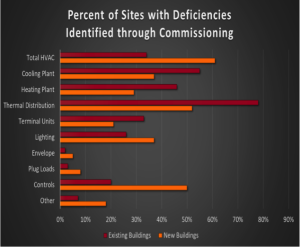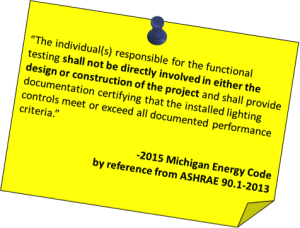
Commissioning: Complying with Code and Keeping within Budget
October 16, 2018
By Sonya M. Pouncy, CEM, CMVP, LEED-AP. Sonya is a senior engineering consultant with Energy Sciences. The firm helps clients meet energy challenges with practical solutions that reduce waste and increase net operating income.
Want to reduce construction project cost overruns? Want to minimize post-construction service call-backs and improve your project’s profitability? One way to help ensure quality and project delivery within budget is to be sure your construction estimate includes the minimum commissioning required by the Michigan Energy Code, which is based on ASHRAE 90.1-2013.
The term commissioning comes from the ship-building industry. A commissioned ship is one that is

Ceremony to Commission the USS Ronald Reagan by Mate First Class Brian Tallette, 2003.
ready and fit for service because it has undergone extensive run-testing in a series of sea trials. For any test not successfully passed, the identified problems are corrected and the test is repeated. After all tests are successfully passed, the crew is thoroughly trained to properly operate and maintain the vessel in accordance with its performance requirements for both favorable and unfavorable conditions. Only after these steps have been fulfilled is the ship deemed ready for use.
Similarly, when applied to a building, commissioning is a quality assurance process to achieve, verify and document that the commissioned assembly—whether it be a single piece of equipment, a building system or an entire building—meets the defined objectives and performance criteria of the owner’s project requirements (OPR) and has a staff ready to operate and maintain it accordingly. Commissioning can begin as early as project ideation and may continue throughout the facility’s lifetime. Commonly, it begins during architectural design development and concludes after turnover to the facility management team. Shrewd building owners, however, understand the long-term value of commissioning and are increasingly requiring it to continue at least through the first year of operation to verify seasonal performance and address warranty issues.
The commissioning process uses various methods to validate performance, including document reviews, checklists and equipment inspections at both delivery and installation; but when most people think of commissioning, what they think of is the field testing, because that is where the “rubber meets the road.”
As far back as the mid-1990’s, Michigan’s energy code has required testing to ensure that HVAC control systems were calibrated, adjusted and in proper working order. This testing is just one of the components of commissioning that happens during the construction phase. It involves checking not just controllers, but also the relevant control panels, sensors, actuators and safeties to ensure they all work properly and in concert to deliver the OPR for comfort and energy efficiency.
In 2008, the state began requiring commissioning of entire HVAC systems for new construction, additions and renovations involving more than 50,000 ft2of conditioned floor area. Commissioning of

Source: Adapted from Building Commissioning: A Golden Opportunity to Reducing Energy Costs and Green House Gas Emissions by Evan Mills, Ph.D. Lawrence Berkeley National Laboratory, 2009.
the HVAC system includes the primary equipment as well as ancillary equipment such as pumps, piping, fans, ductwork and the supporting electrical systems. For these larger projects, the state code requires that commissioning requirements be defined by the design team and detailed in the construction documents. Verifying that commissioning instructions are present is usually one of the things that code officials check when reviewing plans for permitting purposes.
Today, the current Michigan Energy Code (MEC), which became effective in September 2017, includes over 100 updates to help improve building energy performance. One of the more significant updates is the new requirement for the function testing of lighting control systems. Lighting controls, particularly those that have a lot of automation and those for daylighting, require a good deal of field calibration that can be challenging to get just right. A 2009 report from Lawrence Berkeley National Laboratory found that, in a study of more than 350 construction projects across the U.S., nearly 38% experienced problems with lighting systems and 50% had problems with controls that were identified and corrected through the commissioning process.
To ensure that new controls are working properly, the new MEC requires that lighting control system function testing be done for all projects, regardless of size. And, it goes a step farther to define the minimum testing and verification requirements for occupancy/vacancy sensors, daylight responsive sensors and automatic time switches. For example, the MEC requires that record drawings clearly show floor areas that will be exposed to daylight—whether it comes from skylights, roof monitors, clerestories, windows or doors—and which fixtures are under daylighting control. It also requires that the appropriate modulation of luminaire light level in response to available daylight be tested and confirmed. One of the MEC requirements for time switches is that their programming and override time limits be verified. For occupancy sensors, not only does the MEC require operational tests to be performed; it also requires that sensor location and aiming in accordance with manufacturer’s recommendations be certified.

 The cornerstone of the MEC’s requirements for lighting system function testing is that they must be performed by someone not directly involved in either the design or installation of the lighting control system. The biggest benefit of this requirement for third-party testing is that it brings a fresh set of eyes to the quality assurance process. Let’s face it; we’re human and we make mistakes. When we’re close to a project, we may easily overlook its flaws. Certainly, members of the design and construction team have their internal quality control processes; but having a disinterested third-party conducting the final testing brings an additional measure of objectivity. What’s more, a third-party testing provider whose sole focus is quality assurance can also bring value-added resources, efficiencies and insights to the project.
The cornerstone of the MEC’s requirements for lighting system function testing is that they must be performed by someone not directly involved in either the design or installation of the lighting control system. The biggest benefit of this requirement for third-party testing is that it brings a fresh set of eyes to the quality assurance process. Let’s face it; we’re human and we make mistakes. When we’re close to a project, we may easily overlook its flaws. Certainly, members of the design and construction team have their internal quality control processes; but having a disinterested third-party conducting the final testing brings an additional measure of objectivity. What’s more, a third-party testing provider whose sole focus is quality assurance can also bring value-added resources, efficiencies and insights to the project.
So, to avoid the delays associated a documentation code violation and the additional costs and stress of scrambling to finding a third-party commissioning provider at the 11thhour, be sure that your project’s construction documents include all items required by the Michigan Energy Code. Among other things, these include:
- The requirements for lighting control system function testing by a party not involved in the project’s design or construction
- Daylight areas and daylight-controlled luminaires clearly shown on drawings
- The requirements for HVAC control system testing
- Detailed requirements for HVAC system commissioning, for projects with cumulative conditioned areas greater than 50,000 ft2
By following these best practices, you’ll be better able to deliver your construction project on-time and within budget. And, you’ll have a happier owner because they’ll be receiving a building that has the performance and controllability that meets their project requirements.
© 2018 Energy Sciences Resource Partners, LLC





